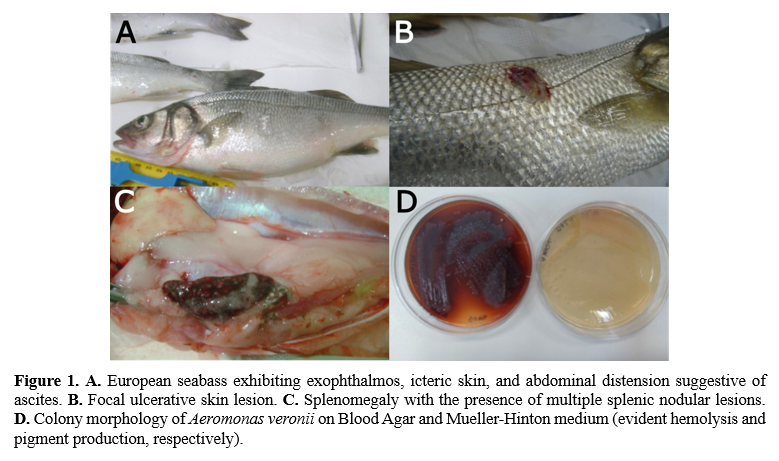Aeromonas veronii IN EUROPEAN SEABASS Dicentrarchus labrax: CLINICAL, MOLECULAR AND EPIDEMIOLOGICAL INSIGHTS FROM GREEK AQUACULTURE
Introduction
Aeromonas veronii has emerged as a significant bacterial pathogen in European seabass (Dicentrarchus labrax) aquaculture across the Aegean Sea (Smyrli et al., 2019, 2017). While traditionally overshadowed by other agents such as Vibrio anguillarum and Photobacterium damselae subsp. pisicida , A. veronii has increasingly been linked to systemic infections, severe mortalities, and economic losses in intensive marine fish farming. The disease affects primarily commercial-sized fish but has also been reported in juveniles under 50 g. Initially restricted to specific regions within the Aegean Sea (East Greece), recent reports indicate a concerning geographic spread to previously unaffected areas, including the Ionian Sea (West Greece) . This trend is particularly alarming given the recent relocation of a significant portion of seabass production to these regions in an effort to escape earlier outbreaks.
In this study, we present new epidemiological data on A. veronii infections in Greece, detailing clinical signs, disease progression, and associated pathology. Furthermore, we evaluate current management strategies and treatment options, with particular emphasis on the role of autogenous vaccines as a key preventive measure.
Materials and methods
Extensive sampling of European seabass exhibiting clinical signs of disease was carried out from April 2024 to April 2025 in the Igoumenitsa Bay region of western Greece. Fish of various size classes were clinically evaluated at both the Irida Fish Disease Diagnosis Laboratory and the Hellenic Centre for Marine Research (HCMR) in Crete.
Bacterial isolation was performed using standard microbiological techniques. Kidney tissues were streaked onto a range of nutrient media, including Tryptic Soy Agar (TSA), Thiosulfate Citrate Bile Salts Sucrose (TCBS) agar, and Blood Agar. Isolates were characterized phenotypically (e.g., pigment production, motility) and biochemically using API 20E and Biolog GEN III systems.
Initial molecular identification involved sequencing of the 16S rRNA and gyrB genes. Selected A. veronii strains underwent whole genome sequencing (WGS) using DNBSeq and Illumina platforms to assess genomic similarity with previously identified strains, as well as to investigate virulence-associated genes and outer membrane protein (OMP) profiles.
Results
The first signs of disease appeared in late April, when water temperatures were relatively low (16–17 °C). Initial mortalities were low but persistent. Clinically, affected fish exhibited lethargy, anorexia, ulcerative skin lesions, exophthalmia, and a distinctly icteric appearance. Internally, splenomegaly was observed, with white to cream-colored nodules of varying sizes present in the spleen, as well as nodules and abscesses in the kidney (Figure 1).
Mortalities increased progressively with rising water temperatures, peaking in late August at 28–29 °C. All bacterial isolates were identified as Aeromonas veronii biovar sobria. The newly isolated strains from Igoumenitsa were motile and showed variability in pigment production. Whole genome phylogenetic analysis revealed that these strains are more closely related to isolates from the eastern Aegean Sea (near the Turkish coast) and are genetically distinct from those previously isolated from the western Aegean (near the Peloponnese). Genomic analysis has shown that the bacterium possesses a very broad toolbox of virulence factors. Several antigenic surface proteins are conserved across different strains, however distinct differences exist between strains according to the geographic area of isolation.
Antibiotic treatment was administered based on antimicrobial susceptibility testing. Most isolates were sensitive to the antibiotics currently approved for use in aquaculture. However, disease management often required multiple treatment cycles. Stress was found to be a critical exacerbating factor, and careful feeding management—especially the avoidance of overfeeding—was essential during periods of elevated water temperature.
Discussion
Aeromonas veronii is now recognized as one of the most significant bacterial pathogens impacting European seabass aquaculture in the eastern Mediterranean, particularly in Greece and Turkey, where the majority of production is concentrated (Smyrli et al., 2019) . Although this pathogen has been associated with disease outbreaks in a wide range of cultured fish species worldwide (Triga et al., 2022), including freshwater and marine species, it has not been detected in gilthead seabream (Sparus aurata), despite co-cultivation in the same facilities. This host specificity is notable and warrants further investigation.
At present, disease control relies primarily on antibiotic therapy—a short-term and unsustainable solution, especially since outbreaks often occur in fish nearing market size. While no commercial vaccines are currently available, the application of autogenous vaccines has shown encouraging results in reducing mortality and disease severity (Smyrli et al., 2022). Advances in molecular and genomic characterization of regional A. veronii strains are laying the groundwork for the development of targeted vaccines and more refined disease management approaches.
Ongoing monitoring and functional studies are essential to deepen our understanding of the pathogen’s transmission routes, resistance potential, and seasonal patterns of occurrence, ultimately contributing to more sustainable and species-specific aquaculture health strategies.
References
Smyrli , M., Anka, I.Z., Koutsoni , O., Dotsika , E., Kyriazis, I.D., Pavlidis, M., Katharios, P., 2022. Development of autogenous vaccines for farmed European seabass against Aeromonas veronii using zebrafish as a model for efficacy assessment. Fish Shellfish Immunol 123, 381–387.
Smyrli , M., Prapas , A., Rigos, G., Kokkari , C., Pavlidis, M., Katharios, P., 2017. Aeromonas veronii infection associated with morbidity and mortality in farmed European seabass (Dicentrarchus labrax ). Fish Pathol 52, 68–81.
Smyrli , M., Triga, A., Dourala , N., Varvarigos , P., Pavlidis, M., Quoc, V.H., Katharios, P., 2019. Comparative study on a novel pathogen of european seabass. Diversity of Aeromonas veronii in the A egean Sea. Microorganisms 7. https://doi.org/10.3390/microorganisms7110504
Triga, A., Smyrli , M., Katharios, P., 2022. Chapter 24 - Aeromoniasis , in: Kibenge , F.S.B., Baldisserotto, B., Chong, R.S.-M. (Eds.), Aquaculture Pathophysiology. Academic Press, pp. 317–327. https://doi.org/https://doi.org/10.1016/B978-0-12-812211-2.00024-X
